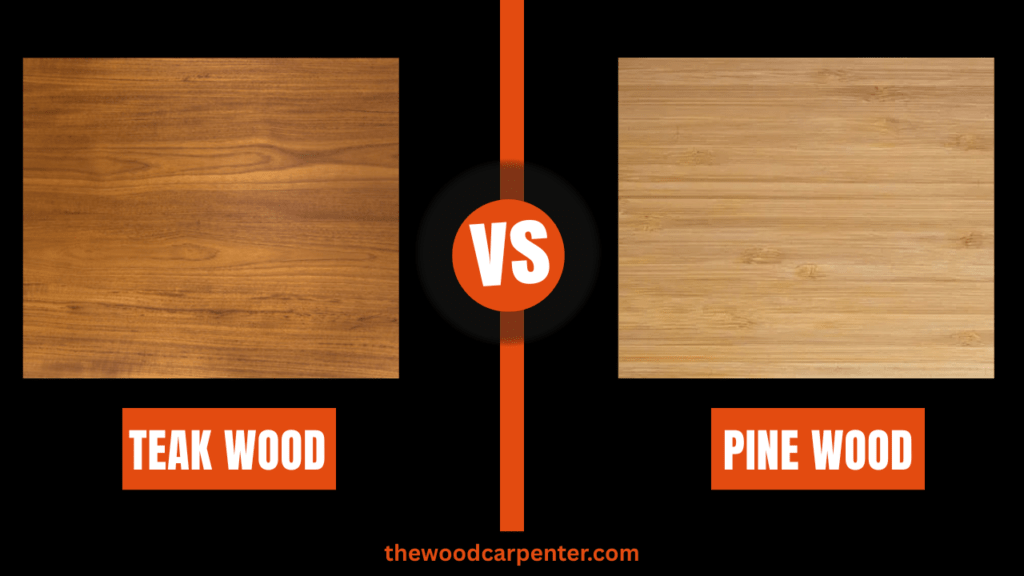
Choosing the Right Wood: Pine vs. Teak
Teak wood and pine wood are two popular types of wood. Choosing the right one is important because each has its own features, strengths, and uses.
This simple guide will help you understand where they come from, what they look like, how strong they are, what they’re used for, and their pros and cons. We’ll also answer some common questions.
What is Pine Wood ?
Where It Comes From
Pine wood comes from pine trees, which grow in North America, Europe, and Asia. It’s a softwood that grows fast, so it’s easy to find and good for the environment.
Look and Feel
- Color: Pine wood is usually creamy white, pale yellow, or light brown. Some types may have a reddish tint.
- Grain and Texture: It has a straight or slightly wavy grain and often has knots that give it a natural, rustic look.
- Finishing: Pine is great for painting, staining, and varnishing. You can change its look easily.
Strength and Durability
- Density: Pine is soft or medium-hard, depending on the type. It’s not as dense as hardwoods.
- Hardness: It has a Janka rating between 380 and 870, which tells us it’s softer than many other woods.
- Resistance: Pine is not very resistant to insects and rot unless it’s pressure-treated or specially treated.
Ease of Use and Common Uses
- Easy to Work With: Because it’s soft, pine is easy to cut, hammer, and carve. That’s why many people use it for DIY and building projects.
- Where It’s Used: Pine is used for furniture, doors, window frames, cabinets, wall panels, floors, and general construction.
Types of Pine Wood
Pine wood comes in many different types, not just one. Each type has its own special features. They are usually grouped by how hard they are or where they come from.
Based on Hardness
Soft Pines (Softer and Lighter):
- Eastern White Pine: Very soft and light. Commonly used for cabinets, wall paneling, and trim work.
- Western White Pine: Has a smooth grain and is great for furniture and indoor use.
- Sugar Pine: The biggest of all pine trees. Has a fine texture, often used for carvings and detailed patterns.
Hard Pines (Also Called Yellow Pines):
- Southern Yellow Pine: Includes types like Loblolly, Shortleaf, Longleaf, and Slash Pine. These are harder and stronger, great for building and heavy-duty work.
- Red Pine (Norway Pine): Medium hardness, good for general construction.
- Scots Pine (European Pine): Often used for both building and furniture.
Based on Region
- Radiata Pine (Insignis Pine): Grown in places like New Zealand, Australia, Chile, and Spain. It’s light, easy to use, and often made into plywood and furniture parts.
- Oregon Pine (Douglas Fir): Not a true pine, but often used like one. It’s strong and used in similar ways.
- German, Russian, and Canadian Pines: These types are popular in international markets and used for building and making furniture.
Related Articles
7 Disadvantages of Douglas Fir Wood You Need to Know
Douglas Fir vs Yellow Pine: Finding the Perfect One
What is Teak Wood ?
Where It Comes From
Teak wood comes from a tree called Tectona grandis. It originally grows in South and Southeast Asia but is now planted in other tropical regions too. Teak is known for being very strong, beautiful, and long-lasting. That’s why many people call it the “King of Woods.”
Look and Feel
- Color: Teak starts out golden or medium brown and becomes darker over time.
- Grain and Texture: It usually has a straight grain but can sometimes be wavy. It feels smooth and slightly oily because it has a lot of natural oils.
- Finishing: It shines beautifully when polished. If left outside without polish, it turns a nice silver-grey color with age.
Strength and Durability
- Density: Teak is quite heavy, with a typical dry weight of about 655 kg/m³.
- Hardness: It has a Janka rating between 1,070 and 1,155 lbf, which means it’s harder than many other furniture woods.
- Resistance: Teak naturally resists rot, termites, fungus, and water damage. That’s why it’s great for outdoor use and even for making boats.
Ease of Use and Common Uses
- Workability: Teak is tough but can still be worked with. However, its oily surface can make gluing difficult, and it can quickly wear down cutting tools due to silica in the wood.
- Where It’s Used: Teak is often used for luxury furniture (both indoor and outdoor), flooring, decks, boats, carvings, and high-end joinery.
- Eco-Friendliness: Teak trees grow slowly, and they are in high demand. That’s why it’s important to buy teak from well-managed and sustainable plantations.
Types of Teak Wood
Teak wood comes in many types. The differences depend on where it’s grown, how old the tree is, and which part of the tree the wood is taken from.
By Region (Where It’s Grown)
- Burmese Teak (Myanmar Teak): The highest quality teak. It has lots of natural oils, a rich golden-brown color, and is very strong. It’s also the most expensive.
- Thai Teak: Very similar to Burmese teak but usually a bit lighter in color and slightly more affordable.
- Indian Teak: Common in India. It’s not as hard or long-lasting as Burmese teak, but it’s cheaper and still widely used.
- Indonesian Teak (Java Teak): Usually grown on plantations. It’s lighter in color, has a smooth grain, and is strong but more affordable than Burmese teak.
- African Teak: Not true teak. This name is used for similar woods like Iroko or Afromosia. These woods look and act like teak, so they’re used in similar ways.
By Age of the Tree
- Old-Growth Teak: Comes from trees that are over 80 years old. This wood is very dense, dark, and durable—highly valued.
- Plantation/Second-Growth Teak: Comes from younger trees, usually 20–40 years old. It’s more eco-friendly and easier to grow, but not as dense or strong as old-growth teak.
By Part of the Tree
- Heartwood Teak: The wood from the center of the tree. It’s darker, rich in oils, and very strong and durable. This is the best quality teak.
- Sapwood Teak: The outer part of the tree. It’s lighter in color, softer, and not as resistant to damage or insects.
Pine Wood vs Teak Wood: Detailed Comparison Table
| Feature | Pine Wood | Teak Wood |
| Botanical Class | Softwood (Pinus genus) | Hardwood (Tectona grandis) |
| Appearance | Light to yellow/pale brown, visible knots, straight grain | Golden to deep brown, straight/smooth grain, sometimes wavy |
| Hardness | 380–870 lbf Janka, softer (varies by species) | 1,070–1,155 lbf Janka, quite hard |
| Durability | Moderate indoors, needs treatment for outdoor use | Superior durability, weather/insect/water-resistant, lasts 50+ years outdoors |
| Common Types | White Pine, Yellow Pine, Red Pine, Scots Pine, Radiata Pine, Sugar Pine | Burmese, Thai, Indian, Indonesian; also heartwood vs sapwood, old vs plantation teak |
| Price | Generally affordable to moderate | Expensive, especially for old-growth or Burmese teak |
| Workability | Excellent—easy to cut, nail, saw, and finish | Dense, needs sharp tools, natural oils can complicate gluing |
| Typical Uses | Construction, cabinetry, flooring, moldings, rustic/painted furniture | Premium indoor/outdoor furniture, decking, marine, flooring, carvings |
| Sustainability | High—fast-growing plantations | Moderate—sustainable plantations exist, but illegal logging is an issue, so look for certified sources |
Also read:
Acacia vs Teak: Comparing Two Popular Hardwoods
Understanding Ebony Wood: A Detailed Breakdown
Pros and Cons
Pine Wood
Pros
- Budget-friendly and accessible worldwide
- Extremely workable—ideal for beginners
- Lightweight, easy to handle
- Accepts finishes well; good for painted or stained projects
- Rapidly renewable, highly sustainable
Cons
- Prone to dents, scratches, and wear
- Less resistant to outdoor elements without treatment
- Visible knots can lead to weaknesses in structural uses
- Requires regular outdoor maintenance
Teak Wood
Pros
- Ultimate durability and weather resistance
- Naturally repels insects and fungus
- Remarkable longevity—frequently outlasts most woods
- Low maintenance—can be left untreated outdoors
- Develops a graceful patina with age
Cons
- High cost (especially for old-growth or Burmese teak)
- Limited availability, possible illegal logging issues
- Heavier—can be cumbersome to transport
- Tools can blunt when working due to high silica content
Frequently Asked Questions (FAQs)
Q1: What’s the difference between soft pine and hard pine?
Soft pines (like Eastern White or Sugar Pine) are lighter, softer, and easier to work with. Hard pines (like Southern Yellow or Red Pine) are heavier, stronger, and better for building structures.
Q2: Why is Burmese teak the best?
Burmese teak has the most natural oil, tight grain, and great weather resistance. It grows slowly and is rare, which makes it more valuable.
Q3: Can I use pine wood outdoors?
Yes, but only if it’s sealed, painted, or pressure-treated. Plain (untreated) pine will rot and get damaged outside over time.
Q4: Is all teak wood equally strong?
No. Teak from older trees (old-growth) and the center of the tree (heartwood) is stronger and lasts longer. Younger or plantation teak is still good, just not as tough as the best quality teak.
Q5: Is pine eco-friendly?
Yes. Pine grows fast and is often replanted responsibly, making it one of the most sustainable wood options.
Q6: How can I make sure my teak is ethically sourced?
Look for wood with FSC (Forest Stewardship Council) or similar certification. This means the wood was grown and harvested in a responsible and legal way.
Q7: Can I mix teak and pine in one project?
Yes, some designers use both—pine for the hidden or inner parts, and teak for the visible or decorative surfaces.
Conclusion
- Pine Wood is great if you’re looking for something affordable, lightweight, easy to use, and eco-friendly. It’s ideal for DIY projects and indoor use.
- Teak Wood is strong, beautiful, and long-lasting. It’s perfect for outdoor furniture, boats, and luxury pieces—but it’s also more expensive.
To choose the right wood, think about:
- Your budget
- Whether it’s for indoor or outdoor use
- The look you want
- How much care and maintenance you’re willing to do
Now that you know more about both pine and teak, you’re ready to pick the best wood for your next project—based on quality, style, and sustainability.

